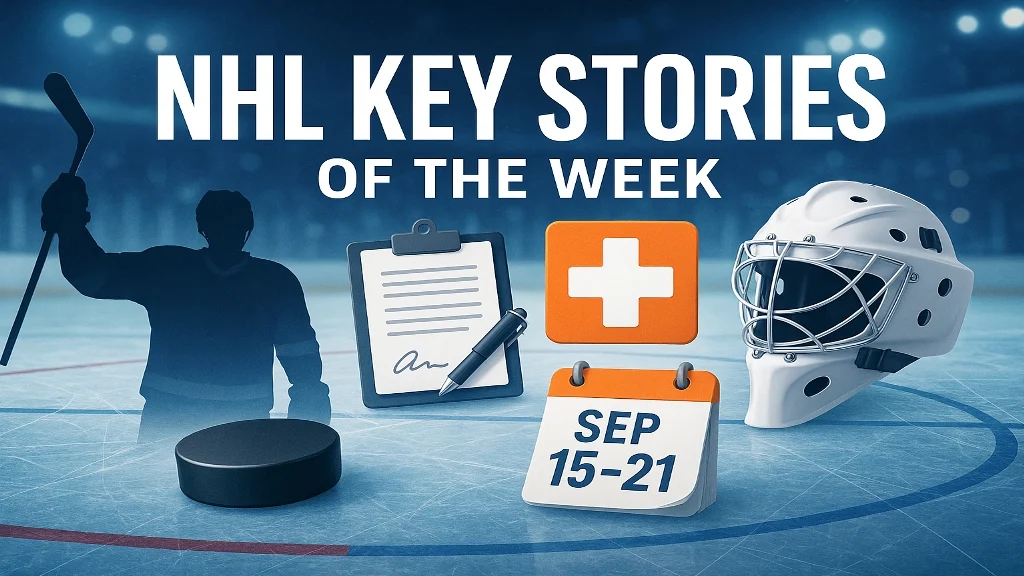Training camps are supposed to be about optimism, new lines, and fresh slates. Instead, this week’s NHL key stories felt like a fast-forward button to opening night pressure. A beloved center told his fan base when the curtain will come down, a captain quietly chose loyalty and flexibility, a young defenseman locked in the kind of bridge that makes development painless, a goalie looked for a change of scenery, and a wave of injuries forced coaches to tear up early depth charts. It was dramatic, not dour — the kind of mix that makes September feel alive and the season to come feel very real.
| Story | Teams Involved | What Happened | Why It Matters |
|---|---|---|---|
| Franchise icon outlines final-season plan | Los Angeles | Veteran leader signals that the 2025–26 campaign will be his last | Emotional clarity for the locker room and long-range cap and leadership planning |
| Captain signs short extension | Calgary | Two-year pact keeps the two-way heartbeat in place | Stability down the middle during a measured retool |
| Young defenseman gets a bridge deal | Chicago | Cost-controlled contract for an everyday blue-liner | Breathing room while top prospects grow into roles |
| Goaltender seeking a reset | Utah | Trade or waivers explored to find a better fit | Clarifies depth chart after summer moves in net |
| Early-camp injuries pile up | Tampa Bay, Pittsburgh, Edmonton, Chicago | Key contributors face multi-week absences | Roster math, LTIR decisions, and opportunity for fringe players |
The captain who chose his exit, and the team that now knows its timeline
Every generation gets a franchise compass, the kind of player whose routine sets the tone for an entire room. When a leader of that stature says, plainly, that the 2025–26 season will be his last, it does more than tug at the heart. It gives a proud team a target. In Los Angeles, the emotional math is simple: one more push with a two-time champion who still wins draws, kills penalties, and calms the game when it’s loudest.
This is one of those NHL key stories that reshapes priorities without a single transaction. Succession planning can finally be spoken out loud. Younger voices can be empowered while the captain is still there to guide them. Management can frame roster moves with honesty — not in whispers, but in open, human terms. Fans will get a proper goodbye, not a midseason rumor mill. And for one of the most respected two-way centers of his era, the farewell tour isn’t about speeches; it’s about standards. The message to the locker room is clear: celebrate, but compete.
Calgary doubles down on identity with a two-year bet on its conscience
The Flames did not swing for headlines; they signed for harmony. A short, two-year extension with their captain reads less like a splash and more like a compass setting. It keeps the matchup monster in the middle of the ice, protects special teams chemistry, and buys time for a retool that has been more about structure than star chasing. The number isn’t the headline; the message is. When your captain chooses term and price that keep the door open to bigger-picture flexibility, the entire roster hears it.
On the ice, this is the kind of NHL key stories decision that invisibly wins you three or four games a year. D-zone starts against top lines still go to your best two-way forward. Kids breaking into the lineup get a security blanket. Wingers who drive play don’t need to carry faceoff burden or penalty-kill stress they’re not built for. It’s a team-friendly, room-friendly outcome that mirrors the way Calgary wants to play.
Chicago’s quiet win: a bridge that fits the moment
A development pipeline only works if you avoid rushing the river. Chicago’s defense is young and talented, but it needs rungs on the ladder, not a fire pole. That’s why a tidy bridge for a dependable everyday defenseman is a bigger deal than it looks. It anchors second-pair minutes at a digestible price, ensures there’s no panic to overplay a prospect in November, and opens the door for internal competition to be healthy, not desperate.
This is one of those NHL key stories that will look smarter in February than it does on paper today. As the schedule compresses and the grind begins, twenty calm minutes a night from a cost-controlled blue-liner stabilize everything else. It’s how you give a creative offensive defenseman the license to jump without worrying the whole plan will wobble if he does. And it’s how you let prospects marinate properly — one league higher than easy, one league lower than overwhelming — until the job becomes theirs on performance, not paperwork.
Utah’s human decision in goal, and the clarity it creates
The modern NHL asks teams to be both ruthless and humane. Utah’s approach with a talented goaltender who’s endured a brutally difficult year managed to be both. Shopping for a trade while staying ready to use waivers if needed isn’t a punishment; it’s a path to fit. The organization, after adding in net over the summer, needed clarity on the depth chart. The player needed a clean restart. This is what alignment looks like.
For a club in a new market hungry for early traction, the decision lands in the sweet spot of pragmatic and compassionate — and that’s why it ranks among the week’s NHL key stories. If a claim or deal materializes, the goalie goes where the opportunity is truer. If not, everyone still knows the plan. Either way, the room gets certainty, the coaches get a camp built on reps rather than speculation, and the front office gets cap math that isn’t written in disappearing ink.
The injury drumbeat that will influence October standings
No team plans to play the opening fortnight without important pieces. Yet here we are, with a cluster of injuries that could tilt early results and, by April, wild-card math. In Tampa Bay, a middle-six rock will be sidelined after an upper-body procedure. In Pittsburgh, a veteran forward who was counted on for stabilizing minutes will miss at least a month just as new systems bed in. In Edmonton, an elite winger recovering from wrist surgery has an early-November target, which puts roster moves and cap relief in the spotlight. In Chicago, a goaltender’s hip surgery clouds the tandem plan and forces contingency thinking.
In isolation, none of these hits sink a season. Together, they make training camp a living jigsaw puzzle. Coaches will audition kids with real minutes rather than safe cameos. General managers will weigh the calculus of using LTIR at the start of the season, knowing that the revised rules around average-salary relief have made timing and precision more important. These aren’t just medical updates; they are NHL key stories with tactical and financial ripple effects that fans will feel the moment lineups are posted.
The PTO twist that reveals this year’s market
If you needed a snapshot of where the cap era sits in 2025, look at the names rolling into camps on professional tryouts. Productive, puck-moving veterans with real resumes are accepting PTOs while front offices protect term and dollars for their own RFAs and high-ceiling kids. It isn’t disrespect; it’s a new equilibrium. Teams love certainty, and a PTO is a cheap, clear way to test for fit while the preseason sorts out health and chemistry.
For Chicago, bringing in a high-assist defenseman on a tryout alongside a newly bridged youngster sends a tidy message. Veterans must still win the job. Prospects must still beat the veteran. Nothing is gifted, and everything is earned. As NHL key stories go, this is one that will echo across the league: don’t be surprised if two or three big-name tryouts convert to one-year deals the minute an injury opens a door.
Remembering giants in goal
Training camp optimism doesn’t erase grief, and the hockey world felt it this month with the loss of two Hall of Fame goaltenders whose names are stitched into the sport’s fabric. In Philadelphia, the legend who backstopped consecutive Cups and charmed generations of fans passed away, prompting tributes that spanned eras. In New York, a Rangers icon known for style and steel left a legacy that will always be part of the Garden’s story.
These are not merely memorials; they are reminders that greatness is measured as much in connection as in trophies. Even within a whirlwind of NHL key stories, the game found time to stand still and say thank you.
The LTIR wrinkle fans will actually notice on game nights
Cap mechanics often feel like homework, but the updated guidance around long-term injured reserve has moved from the back office to the broadcast. By anchoring certain calculations to average salary and tightening the timeline gamesmanship around opening night, the rules have nudged clubs toward cleaner decisions. For fans, that means fewer paper call-ups that vanish after warmups and more straightforward answers to the simple question: when is the player truly ready?
This matters now because those early injuries dovetail with the calendar. If a star’s return date lines up more neatly with cap relief, that isn’t cynicism; it’s compliance. If a team opts not to use LTIR immediately, it may be because future flexibility outweighs the short-term fix. As NHL key stories go, this one is subtle — until you realize it can affect who plays in week one and how lines look in week three.
What it all adds up to as preseason ramps up
Strip away the noise, and you’re left with a league that just told on itself. Leadership still matters, and when a captain chooses clarity, it galvanizes a group. Stability down the middle is priceless, which is why Calgary’s two-year pact will age so well. Development is a staircase, not a trampoline; Chicago’s bridge deal proves the front office knows the difference. Honesty about fit can be kindness; Utah’s goaltending decision is proof. And health is destiny in October; the teams that manage the next two weeks with calm and creativity will pocket points they’ll be grateful for in spring.
That’s why this roundup of NHL key stories isn’t just a tidy who-did-what. It’s a map of where pressure will live in the first month. Los Angeles will carry emotion and expectation in equal measure. Calgary will bank on structure and a quiet center who keeps the ice tilted the right way. Chicago will test patience and depth at the same time, with a tryout wild card ready if needed. Utah will seek equilibrium in net and identity in front of it. Tampa Bay, Pittsburgh, Edmonton, and Chicago will run rolling auditions that could produce a rookie story we’re all writing in November.
Team-by-team snapshot you can actually use
Los Angeles knows the stakes now. A farewell season is both a celebration and a challenge, and the way the Kings manage minutes will reflect that split-screen reality. You’ll see subtle matchup tweaks, an emphasis on clean breakouts that don’t rely on heroics, and a premium on faceoff detail. This is how a veteran group honors an icon without turning 82 games into a tribute tour.
Calgary’s best path looks familiar: suffocate the middle of the ice, turn neutral-zone patience into offensive-zone wear-downs, and let special teams steal the odd night. With the captain locked in, the coaching staff has the credibility to spread tough minutes and trust the identity. The kids will get rope, not a rescue mission.
Chicago’s plan is almost artisanal in its patience. The bridge creates the space to test pairings without detonating confidence. One night, a young puck-mover rides shotgun with the steady hand; another night, the matchups flip to protect fatigue. If the PTO hits, it’s a bonus. If it doesn’t, nothing breaks.
Utah’s equation is more delicate. A new market needs touchstones, and goaltending is the most visible one there is. Finding the right home for a goalie who needs it isn’t just an asset play; it’s brand stewardship. Expect the team to lean into defensive support early, defend the slot in five-man pictures, and keep risk measured until chemistry catches up.
The injury-hit clubs will look like laboratories, and that’s not an insult. It’s the truth of September in a league this tight. Opportunity will create a handful of names you didn’t expect to see on opening night, plus a veteran or two who win jobs because they simply do the simple things better than the next guy.
Why this week felt like a hinge
Most Septembers slide by in hopeful clichés. This one didn’t. It handed us NHL key stories with stakes: legacy, identity, development, compassion, and the cold math of cap space meeting human healing. It’s a better way to start, frankly, because it respects the audience. Fans don’t need slogans; they need the whole picture, and this week gave it to them.
If there’s a single throughline, it’s clarity. Clarity from a captain who chose his ending. Clarity from a franchise that chose to keep its conscience. Clarity from a front office that knows how to build a staircase for young defensemen. Clarity from a team that chose a player’s well-being and its own depth chart at the same time. Clarity from injuries that will force honest assessments and from rules that reward straightforward answers. Clarity doesn’t win a Cup. But it wins days, and in a league this close, days stack up.
FAQs
What makes this roundup of NHL key stories different from a standard recap?
This isn’t a list of transactions; it’s an explanation of why each development matters on the ice and in the room. The focus is on how leadership calls, contract structures, health updates, and tryouts translate into matchups, minutes, and results.
Why is a captain announcing his final season such a big deal?
Because it turns sentiment into structure. Coaches can plan succession, veterans can calibrate their roles, and younger players know exactly what standard they’re chasing. It’s one of those NHL key stories that changes the emotional temperature without a single trade.
How does a short captain’s extension help a team in transition?
It keeps the identity intact. A two-way center who takes tough matchups and kills penalties stabilizes systems, lets prospects grow in sane minutes, and keeps the club from shopping for an expensive quick fix that doesn’t fit.
What is the value of a bridge deal for a young defenseman?
It buys time without blocking the pipeline. The team gets cost certainty and a trustworthy 18–20 minutes a night, while prospects develop at the right pace. It’s a classic NHL key stories move that looks small now and smart later.
Why do veterans accept PTOs in today’s market?
Because the cap’s middle class is squeezed. A PTO is a stage, not a stigma. It lets a veteran show he can fill a specific need at a price and term that make sense. Injuries and underperforming camps often turn a tryout into a contract.
How will early injuries actually change lineups?
They promote auditions from theory to reality. Fringe forwards get second-line shifts, rookie defensemen get penalty-kill reps, and teams must decide whether to use early LTIR, which affects how quickly a star can return and how the cap picture evolves.
What’s different about LTIR this season?
The tightened rules around average-salary relief and timing limit the old paper-shuffle theatrics. Fans should see fewer one-day cap tricks and more straight answers about when a player is ready. It’s a quieter NHL key stories change with big practical impact.
Why mention the passing of legendary goaltenders in a week of camp news?
Because the sport is bigger than the standings. Remembering icons during camp connects new stories to old ones, grounding all the news — signings, injuries, tryouts — in the game’s shared memory.
Which team benefits most from this week’s clarity?
Los Angeles gets emotional focus, Calgary gets structural stability, Chicago gets developmental room, and Utah gets a clearer roadmap in net. The injury-affected teams get truth — and the chance for a surprise contributor to change their fall.
What should fans watch for next week?
Look for PTOs converting to contracts, first real special-teams reps for rookies, and subtle leadership shifts as teams settle on alternate captains and penalty-kill units. These are small NHL key stories that add up before anyone has a point in the standings.







